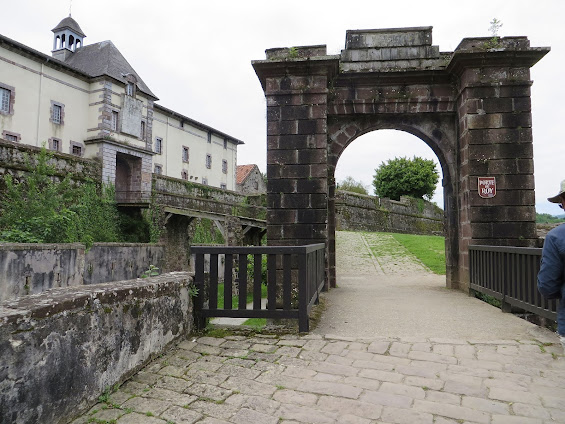At breakfast before sightseeing in St. Jean
After eating, we bid "Buen Camino" to those starting their first day of walking, including Kip & his daughter who are leading a student group from Christopher Newport University.
I'm sitting next to Paulina (from Australia) and across from Mary Margaret from S. Carolina. Dad is next to Michael from Concord, California (near San Francisco) and at the end is Brook from Oregon. Lots of Americans are staying at this gite -- perhaps hearing about it on pilgrim forums like I did.
Walking sticks waiting to go
At the Pilgrim Office located across from L'Esprit we got our credencials stamped and bought shells for our backpacks.
Pictures below include the 17th c. citadel (now a school) and our street, Rue de la Citadelle, the cobbled Road through the medieval part of town.
The buildings on Rue de la Citadelle incorporate red sandstone and reflect typical Basque architecture.
Walking on the old wall that protected St. Jean in centuries past
St. Jean's fortress La Citadelle, originally constructed in 1628
The Nive River passes through St. Jean. In the background is the scenic Pont d'Eyheraberry, also known as the "Pilgrims' Bridge." It's the point where Rue de la Citadelle becomes Rue d'Espagne, or Street of Spain, that leads out of town up to the Roncevaux Pass.
Pont d'Eyheraberry -- "eyheraberry" means "new mill" in Basque
Besides being a major pilgrim portal, St. Jean is known for espadrille shoes and canvas fabrics, which were colorfully displayed in shops.
A refuge (albergue) sign reads "On the way... to the crowing of the rooster"
At Notre Dame du Bout du Pont (Our Lady at the End of the Bridge) from the 14th c. an ex-voto (ovaries & uterus) was left along with a donation and note explaining whom the object represented.
Below is the portal of Notre Dame du Bout du Pont. Around the top of the doorway are "grotesques," which are carvings of faces, animals, or vegetation that are architectural features originating in the Classical period. Besides functioning as decoration, these fanciful forms served to ward off evil spirits.






.jpg)














No comments:
Post a Comment